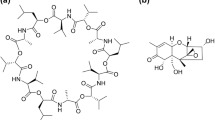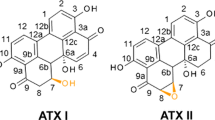Abstract
Deoxynivalenol (DON), nivalenol (NIV), T-2 toxin (T2), fumonisin B1 (FB1), zearalenone (ZEA), and moniliformin (MON) mycotoxins are common food and feed contaminants produced by Fusarium spp. However, while they are usually found to co-occur in a large range of commodities, only few data are available on mycotoxin co-exposure effects and cellular response mechanisms. In this study, the individual and combined toxic effects of these fusariotoxins were evaluated on the THP-1 human immune cell line as major fusariotoxins are mostly potent immunomodulators. In particular, four relevant fusariotoxin mixtures, namely DON-MON, DON-FB1, DON-ZEA, and NIV-T2, were studied using several parameters including cell viability as well as the expression of cell surface markers and the main mitogen-activated protein kinases (MAPKs). After 48 h exposure, a reduction of cell viability in a dose-dependent manner was observed for T2, the most cytotoxic mycotoxin, followed by NIV, DON, MON, FB1, and ZEA. Regarding mycotoxin mixtures, they mainly showed antagonism on cell viability reduction. Interestingly, at concentrations inhibiting 50% of cell viability, most viable cells exhibited surface marker loss and thus became potentially non-functional. In addition, during the first 18 h of exposure, the effects of mycotoxin mixtures on early cell apoptosis and necrosis were found to be different from those induced by the toxins alone. At the molecular level, after 1 h exposure of individual and combined mycotoxins, the three main MAPK signaling pathways (p38, SAPK/JNK, and ERK1/2) were activated, highlighting a fast reaction of the exposed cells even at low cytotoxicity levels.







Similar content being viewed by others
Abbreviations
- BEA:
-
Beauvericin
- DiOC6(3):
-
3,3′-Dihexyloxacarbocyanine iodide
- DON:
-
Deoxynivalenol
- ENNs:
-
Enniatins
- FB1:
-
Fumonisin B1
- IC50 :
-
Inhibitory concentration 50%
- MAPKs:
-
Mitogen-activated protein kinases
- MON:
-
Moniliformin
- MTP:
-
Mitochondrial transmembrane potential
- MTS:
-
3-(4,5-Dimethylthiazol-2-yl)-5-(3-carboxymethoxyphenyl)-2-(4-sulfophenyl)-2H-tetrazolium
- NIV:
-
Nivalenol
- PS:
-
Phosphatidylserine
- T2:
-
T-2 toxin
- TCT:
-
Trichothecenes
- ZEA:
-
Zearalenone
References
Alassane-Kpembi I, Schatzmayr G, Taranu I, Marin D, Puel O, Oswald IP. Mycotoxins co-contamination: methodological aspects and biological relevance of combined toxicity studies. Crit Rev Food Sci Nutr. 2016; doi:10.1080/10408398.2016.1140632.
Baltriukiene D, Kalvelyte A, Bukelskiene V. Induction of apoptosis and activation of JNK and p38 MAPK pathways in deoxynivalenol-treated cell lines. Altern Lab Anim ATLA. 2007;35:53–9.
Bennett JW, Klich M. Mycotoxins. Clin Microbiol Rev. 2003;16:497–516.
Bensassi F, Gallerne C, Sharaf el dein O, Hajlaoui MR, Lemaire C, Bacha H. In vitro investigation of toxicological interactions between the fusariotoxins deoxynivalenol and zearalenone. Toxicon. 2014;84:1–6. doi:10.1016/j.toxicon.2014.03.005.
Bimczok D, Döll S, Rau H, Goyarts T, Wundrack N, Naumann M, et al. The Fusarium toxin deoxynivalenol disrupts phenotype and function of monocyte-derived dendritic cells in vivo and in vitro. Immunobiology. 2007;212:655–66. doi:10.1016/j.imbio.2007.05.002.
BIOMIN 2016. BIOMIN World Mycotoxin Survey 2016 [WWW Document]. URL https://info.biomin.net/acton/attachment/14109/f-0463/1/-/-/l-0009/l-0009:712e/MAG_MTXsurveyReport_2016_EN_0117_PKO.pdf (accessed 5.4.17).
Bouaziz C, Bouslimi A, Kadri R, Zaied C, Bacha H, Abid-Essefi S. The in vitro effects of zearalenone and T-2 toxins on Vero cells. Exp Toxicol Pathol. 2013;65:497–501. doi:10.1016/j.etp.2012.02.005.
Castedo M, Hirsch T, Susin SA, Zamzami N, Marchetti P, Macho A, et al. Sequential acquisition of mitochondrial and plasma membrane alterations during early lymphocyte apoptosis. J Immunol Baltim Md. 1996;1950(157):512–21.
Cetin Y, Bullerman LB. Cytotoxicity of Fusarium mycotoxins to mammalian cell cultures as determined by the MTT bioassay. Food Chem Toxicol. 2005;43:755–64. doi:10.1016/j.fct.2005.01.016.
Chanput W, Mes JJ, Wichers HJ. THP-1 cell line: an in vitro cell model for immune modulation approach. Int Immunopharmacol. 2014;23:37–45. doi:10.1016/j.intimp.2014.08.002.
da Rocha MEB, Freire FDCO, Maia FEF, Guedes MIF, Rondina D. Mycotoxins and their effects on human and animal health. Food Control. 2014;36:159–65. doi:10.1016/j.foodcont.2013.08.021
Ficheux AS, Sibiril Y, Le Garrec R, Parent-Massin D. In vitro myelotoxicity assessment of the emerging mycotoxins beauvericin, enniatin B and moniliformin on human hematopoietic progenitors. Toxicon. 2012a;59:182–91. doi:10.1016/j.toxicon.2011.11.006.
Ficheux AS, Sibiril Y, Parent-Massin D. Co-exposure of Fusarium mycotoxins: in vitro myelotoxicity assessment on human hematopoietic progenitors. Toxicon. 2012b;60:1171–9. doi:10.1016/j.toxicon.2012.08.001.
Ficheux AS, Sibiril Y, Parent-Massin D. Effects of beauvericin, enniatin b and moniliformin on human dendritic cells and macrophages: an in vitro study. Toxicon. 2013;71:1–10. doi:10.1016/j.toxicon.2013.04.024.
Fontaine, K., Mounier, J., Coton, E., Hymery, N. Individual and combined effects of roquefortine C and mycophenolic acid on human monocytic and intestinal cells. World Mycotoxin J. 2015;9(1):51–62. doi:10.3920/WMJ2014.1861
Gathercole PS, Thiel PG, Hofmeyr JHS. Inhibition of pyruvate dehydrogenase complex by moniliformin. Biochem J. 1986;233:719–23. doi:10.1042/bj2330719.
Geske FJ, Lieberman R, Strange R, Gerschenson LE. Early stages of p53-induced apoptosis are reversible. Cell Death Differ. 2001;8:182.
Groothuis FA, Heringa MB, Nicol B, Hermens JLM, Blaauboer BJ, Kramer NI. Dose metric considerations in in vitro assays to improve quantitative in vitro–in vivo dose extrapolations. Quantitative in vitro to in vivo extrapolation (QIVIVE): An essential element for in vitro-based risk assessment. Toxicology. 2015;332:30–40. doi:10.1016/j.tox.2013.08.012.
Hymery N, Sibiril Y, Parent-Massin D. In vitro effects of trichothecenes on human dendritic cells. Toxicol in Vitro. 2006;20:899–909. doi:10.1016/j.tiv.2006.01.015.
Hymery N, Léon K, Carpentier F-G, Jung J-L, Parent-Massin D. T-2 toxin inhibits the differentiation of human monocytes into dendritic cells and macrophages. Toxicol in Vitro. 2009;23:509–19. doi:10.1016/j.tiv.2009.01.003.
Jestoi M. Emerging Fusarium-mycotoxins fusaproliferin, beauvericin, enniatins, and moniliformin—a review. Crit Rev Food Sci Nutr. 2008;48:21–49. doi:10.1080/10408390601062021.
Kouadio JH, Dano SD, Moukha S, Mobio TA, Creppy EE. Effects of combinations of Fusarium mycotoxins on the inhibition of macromolecular synthesis, malondialdehyde levels, DNA methylation and fragmentation, and viability in Caco-2 cells. Toxicon. 2007;49:306–17. doi:10.1016/j.toxicon.2006.09.029.
Kuiper GGJM, Lemmen JG, Carlsson B, Corton JC, Safe SH, van der Saag PT, et al. Interaction of estrogenic chemicals and phytoestrogens with estrogen receptor β. Endocrinology. 1998;139:4252–63. doi:10.1210/endo.139.10.6216.
Kuiper-Goodman T, Scott PM, Watanabe H. Risk assessment of the mycotoxin zearalenone. Regul Toxicol Pharmacol. 1987;7:253–306. doi:10.1016/0273-2300(87)90037-7.
Lee S-H, Meng XW, Flatten KS, Loegering DA, Kaufmann SH. Phosphatidylserine exposure during apoptosis reflects bidirectional trafficking between plasma membrane and cytoplasm. Cell Death Differ. 2013;20:64–76. doi:10.1038/cdd.2012.93.
Marzocco S, Russo R, Bianco G, Autore G, Severino L. Pro-apoptotic effects of nivalenol and deoxynivalenol trichothecenes in J774A.1 murine macrophages. Toxicol Lett. 2009;189:21–6. doi:10.1016/j.toxlet.2009.04.024.
Ozgen U, Savaşan S, Buck S, Ravindranath Y. Comparison of DiOC(6)(3) uptake and annexin V labeling for quantification of apoptosis in leukemia cells and non-malignant T lymphocytes from children. Cytometry. 2000;42:74–8.
Pan X, Whitten DA, Wu M, Chan C, Wilkerson CG, Pestka JJ. Global protein phosphorylation dynamics during deoxynivalenol-induced ribotoxic stress response in the macrophage. Toxicol Appl Pharmacol. 2013;268:201–11. doi:10.1016/j.taap.2013.01.007.
Pinton P, Tsybulskyy D, Lucioli J, Laffitte J, Callu P, Lyazhri F, et al. Toxicity of deoxynivalenol and its acetylated derivatives on the intestine: differential effects on morphology, barrier function, tight junctions proteins and mitogen-activated protein kinases. Toxicol Sci. 2012; doi:10.1093/toxsci/kfs239.
Ren Z, Wang Y, Deng H, Deng Y, Deng J, Zuo Z, et al. Deoxynivalenol induces apoptosis in chicken splenic lymphocytes via the reactive oxygen species-mediated mitochondrial pathway. Environ Toxicol Pharmacol. 2015;39:339–46. doi:10.1016/j.etap.2014.11.028.
Rodrigues I, Naehrer K. A three-year survey on the worldwide occurrence of mycotoxins in feedstuffs and feed. Toxins. 2012;4:663–75. doi:10.3390/toxins4090663.
Smith M-C, Madec S, Coton E, Hymery N. Natural co-occurrence of mycotoxins in foods and feeds and their in vitro combined toxicological effects. Toxins. 2016;8:94. doi:10.3390/toxins8040094.
Solhaug A, Karlsøen LM, Holme JA, Kristoffersen AB, Eriksen GS. Immunomodulatory effects of individual and combined mycotoxins in the THP-1 cell line. Toxicol in Vitro. 2016;36:120–32. doi:10.1016/j.tiv.2016.07.012.
Soriano JM, González L, Catalá AI. Mechanism of action of sphingolipids and their metabolites in the toxicity of fumonisin B1. Prog Lipid Res. 2005;44:345–56. doi:10.1016/j.plipres.2005.09.001.
Thiel PG. A molecular mechanism for the toxic action of moniliformin, a mycotoxin produced by Fusarium moniliforme. Biochem Pharmacol. 1978;27:483–6. doi:10.1016/0006-2952(78)90381-7.
Thuvander A, Wikman C, Gadhasson I. In vitro exposure of human lymphocytes to trichothecenes: individual variation in sensitivity and effects of combined exposure on lymphocyte function. Food Chem Toxicol. 1999;37:639–48. doi:10.1016/S0278-6915(99)00038-1.
Waché YJ, Hbabi-Haddioui L, Guzylack-Piriou L, Belkhelfa H, Roques C, Oswald IP. The mycotoxin deoxynivalenol inhibits the cell surface expression of activation markers in human macrophages. Toxicology. 2009;262:239–44. doi:10.1016/j.tox.2009.06.014.
Wan LYM, Turner PC, El-Nezami H. Individual and combined cytotoxic effects of Fusarium toxins (deoxynivalenol, nivalenol, zearalenone and fumonisins B1) on swine jejunal epithelial cells. Food Chem Toxicol. 2013;57:276–83. doi:10.1016/j.fct.2013.03.034.
Weber F, Freudinger R, Schwerdt G, Gekle M. A rapid screening method to test apoptotic synergisms of ochratoxin A with other nephrotoxic substances. Toxicol in Vitro. 2005;19:135–43. doi:10.1016/j.tiv.2004.08.002.
Yang G-H, Jarvis BB, Chung Y-J, Pestka JJ. Apoptosis induction by the satratoxins and other trichothecene mycotoxins: relationship to ERK, p38 MAPK, and SAPK/JNK activation. Toxicol Appl Pharmacol. 2000;164:149–60. doi:10.1006/taap.1999.8888.
Yazar S, Omurtag GZ. Fumonisins, trichothecenes and zearalenone in cereals. Int J Mol Sci. 2008;9:2062–90. doi:10.3390/ijms9112062.
Yu J-Y, Zheng Z-H, Son Y-O, Shi X, Jang Y-O, Lee J-C. Mycotoxin zearalenone induces AIF- and ROS-mediated cell death through p53- and MAPK-dependent signaling pathways in RAW264.7 macrophages. Toxicol in Vitro. 2011;25:1654–63. doi:10.1016/j.tiv.2011.07.002.
Zinedine A, Brera C, Elakhdari S, Catano C, Debegnach F, Angelini S, et al. Natural occurrence of mycotoxins in cereals and spices commercialized in Morocco. Food Control. 2006;17:868–74. doi:10.1016/j.foodcont.2005.06.001.
Acknowledgements
M-C Smith was funded by the Région Bretagne in the framework of the ARED Mumycel project. The authors are thankful to Arthur Marie (Université de Brest) for his technical assistance with western blot analyses.
Author information
Authors and Affiliations
Corresponding author
Ethics declarations
Conflict of interest
The authors declare that there are no conflicts of interest.
Rights and permissions
About this article
Cite this article
Smith, MC., Madec, S., Troadec, S. et al. Effects of fusariotoxin co-exposure on THP-1 human immune cells. Cell Biol Toxicol 34, 191–205 (2018). https://doi.org/10.1007/s10565-017-9408-7
Received:
Accepted:
Published:
Issue Date:
DOI: https://doi.org/10.1007/s10565-017-9408-7




